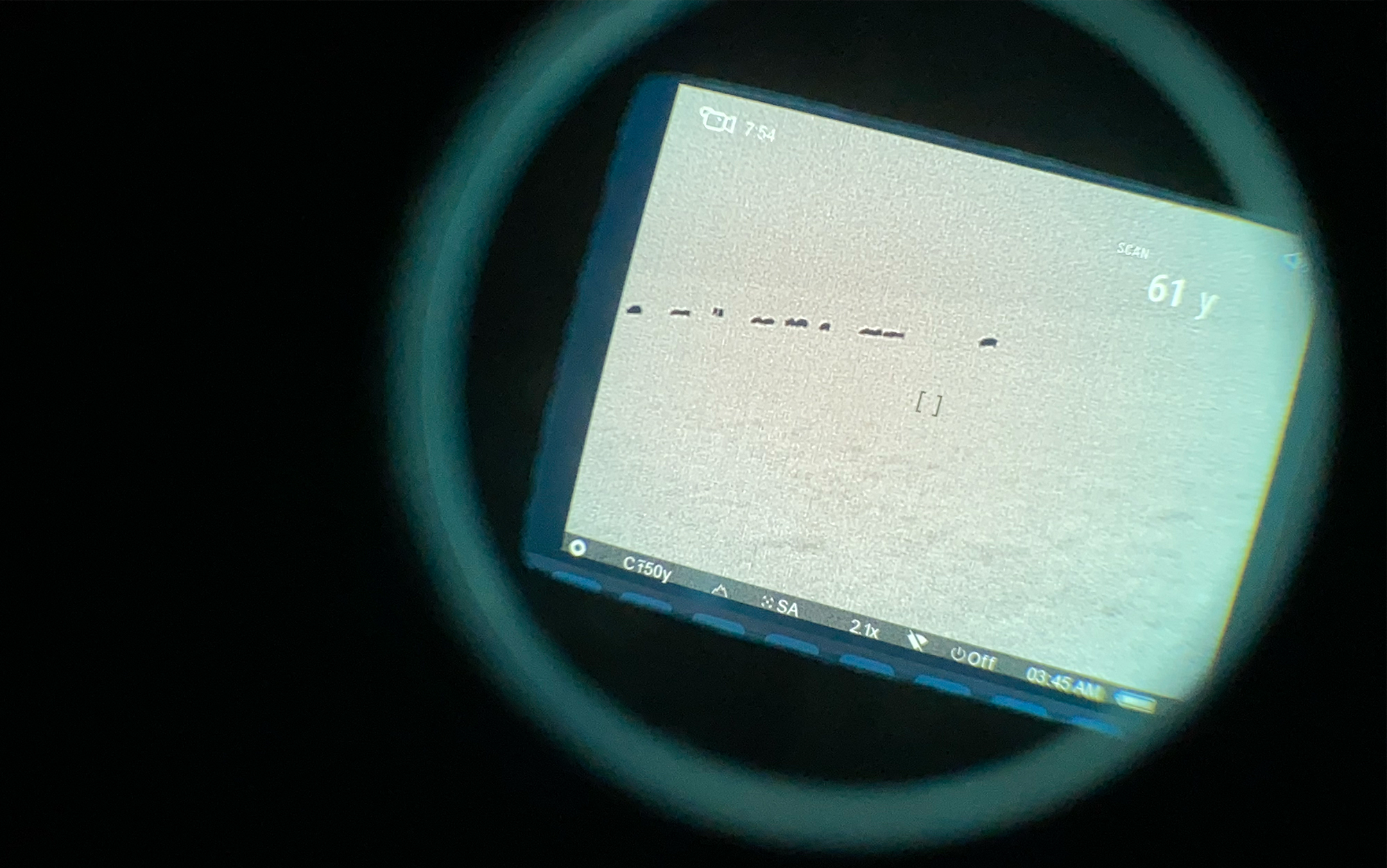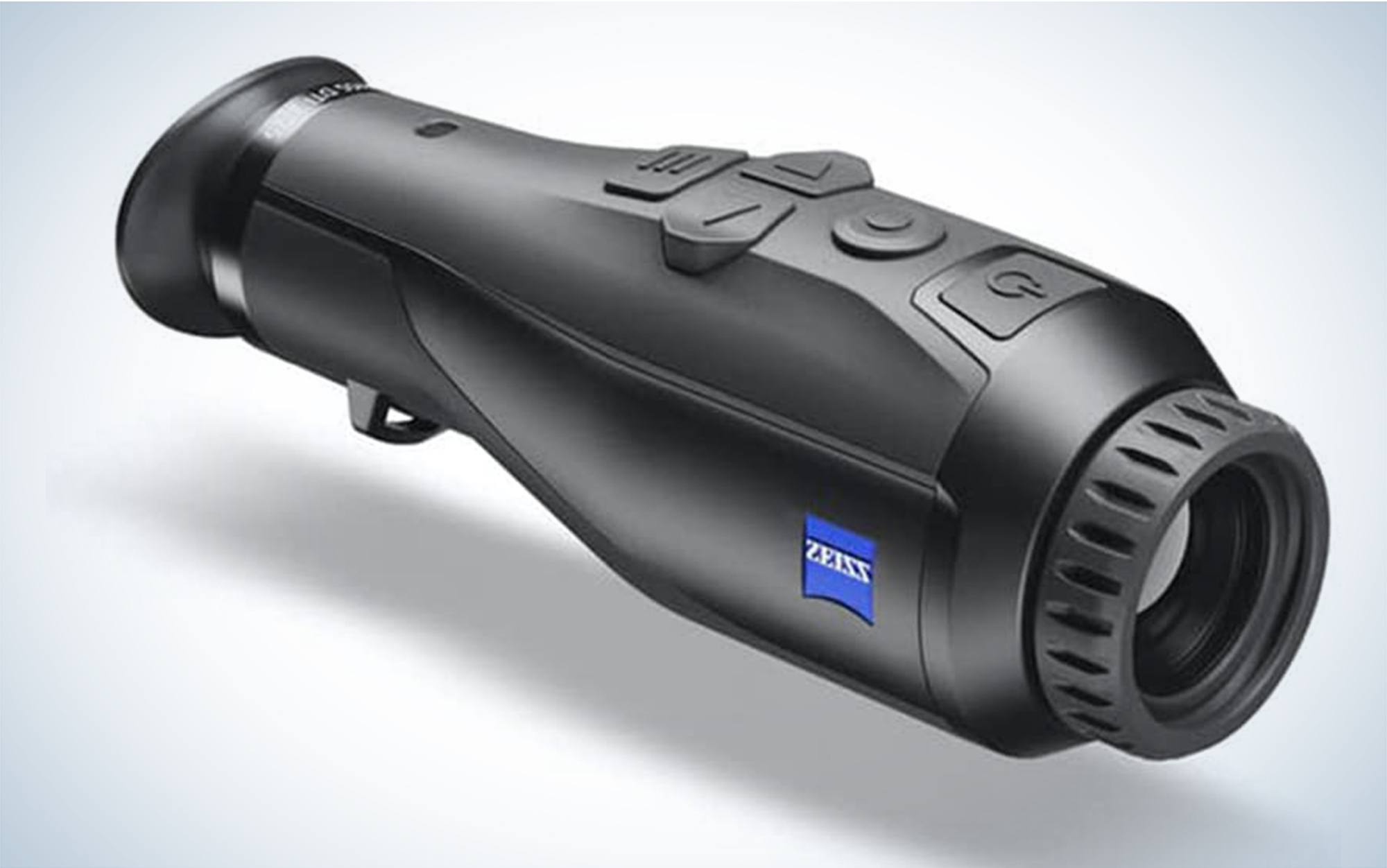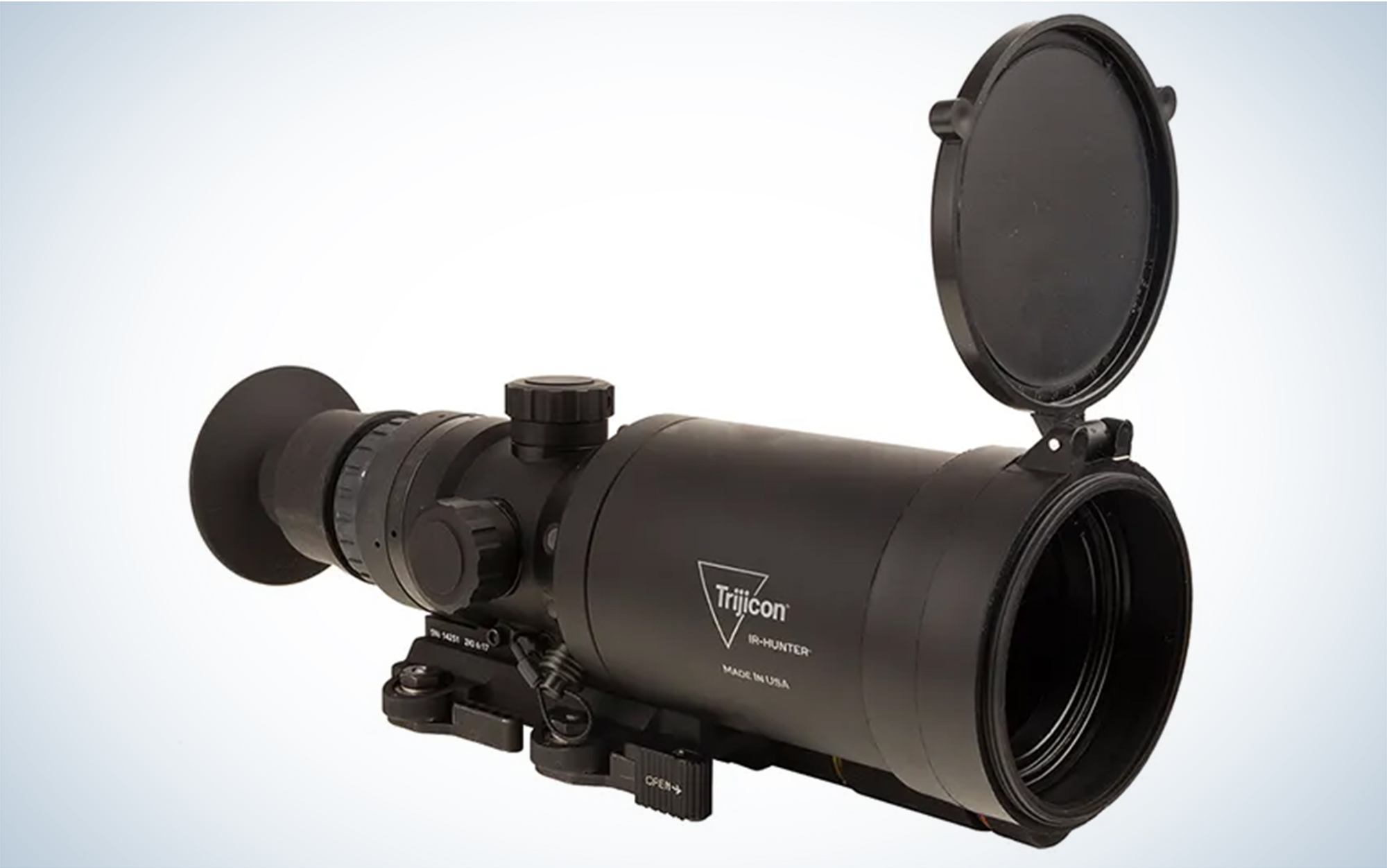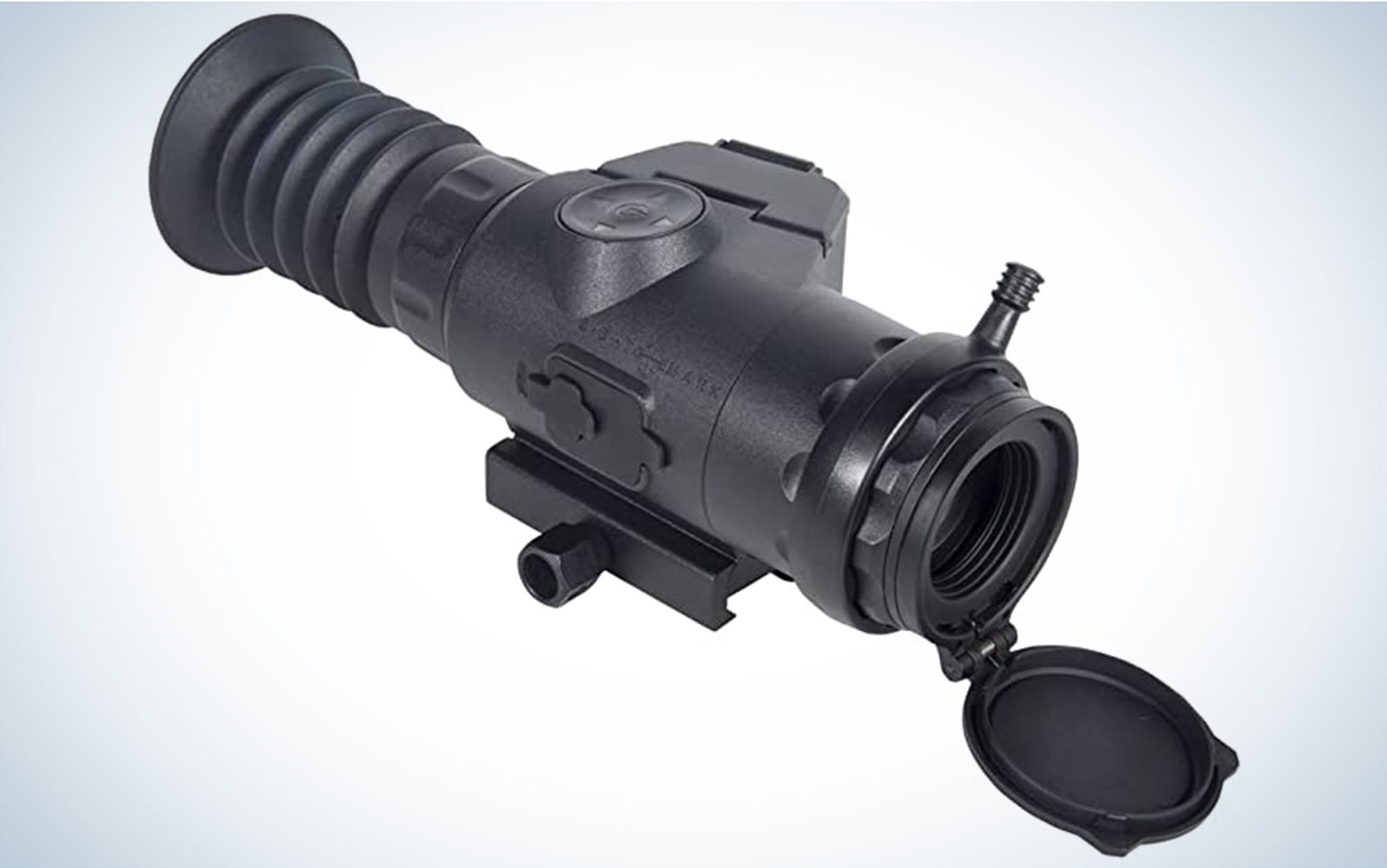We may earn revenue from the products available on this page and participate in affiliate programs. Learn More ›
Updated Apr 18, 2023 1:30 PM
Thermal scopes don’t just level the playing field; they tip the field decidedly in favor of users because they cheat nature by allowing us to see through the dark. The advantage they give hunters is the main reason they’re prohibited for most game hunting. But for unregulated non-game animals, like coyotes and feral hogs in many states, they’re an unequaled aid. They have plenty of other uses, from finding your child in the dark to detecting electrical shorts inside walls.
It’s a category in the process of rapid evolution. New models have on-board rangefinders, high-definition video and still photo capability, and even Bluetooth connections to mobile apps. Even better, the price for many of these units has fallen to a level where they’re affordable for nearly every budget. So which thermal is for you? Read on for reviews of the best thermal scopes available.
Best Thermal Scopes: Reviews & Recommendations
Best Overall: Pulsar Thermion 2 LRF PRO
Key Features
- Capable of detecting heat signatures out to 2,000 yards
- Built-in laser rangefinder has a stated range of 875 yards, and effective range of about 500 yards
- 2-16-power magnification range
- Built-in photo and video recording, which can be stored on 16GB memory or streamed via on-board Wi-Fi to mobile app
- Ten digital reticles
- Nine different color palettes
Pros
- Tons of useful features
- Long detection range
- Excellent resolution and detail
- Intuitive ergonomics
Cons
- Limited inventory (currently)
- Refresh rate could be faster
In terms of products available on the civilian market, this rangefinding riflescope has the best combination of range, detection sensitivity, ease of use, and ample mounting dimensions. It’s also among the more durable units, and its combination of on-board and removable batteries is a key asset to keep it cranking in cold weather. Its data-capture-and-share capability is impressive. It has the ability to record both photos and videos, and then share to a mobile app via its built-in Wi-Fi.


While the unit can detect heat signatures out to 2,000 yards, it only really becomes useful inside about 500 yards, when images start to gain resolution and the rangefinder—rated out to 875 yards—can identify targets quickly and with pretty good precision. The rangefinder has an inclinometer, unusual in this class of scope, and a ballistic calculator that can prescribe shooting solutions. The magnification range—2x out to 16x—is useful, as is the ability to choose between 10 reticles and nine different color modes. For precision shooting, the “picture-in-picture” mode, which magnifies the aiming point, is a useful feature.
The ergonomics and ease of use are both excellent, starting with the ambidextrous focus control on the thermal housing near the objective bell. The three-button control pad near the eyepiece is intuitive and textured to make navigation in total darkness repeatable after a few uses.
In terms of its guts, the Thermion 2 is powered by a 640×480 microbolometer resolution sensor and a sharp 1024×768 AMOLED display that pops against just about any background.
Let’s talk about its price—over $6,500—and its scarcity. This product hasn’t been available for a few months, and there’s a good deal of uncertainty over sourcing for a number of brands, besides Pulsar. It’s enough to suggest that instead of germanium, the material thermal manufacturers are using might as well be called unobtanium.
While much of the Thermion 2 looks and behaves like a traditional riflescope, the processor that’s mounted above the objective bell is bulky and throws off the balance. The refresh rate is better than earlier iterations of this scope, but I still wish it was a little faster. While using this scope on a Texas hog hunt, I found that it froze at the most inopportune moments, a situation that’s easy to resolve with manual refresh.
Best Handheld: Zeiss DTI 3/35
Key Features
- Weight: 14.5 ounces
- Height: 2.6 inches
- Display: 1.6 inches
- Magnification: 1-4-power
- Thermal Sensor Resolution: 384 x 288
- Display Resolution: 1280 x 960
- Pixel Pitch: 17 um
- Frame Rate: 50Hz
- Field of View: 57 feet at 100 yards
- Range: 1,350 yards
- Four color palettes (white hot, black hot, red hot, rainbow)
Pros
- Picture-in-picture feature
- Hot tracking mode
- High frame rate reduces flickering
- Bluetooth connectivity with Zeiss Hunting app
- Excellent controls and ergonomics
- Good battery life
Cons
- At about $3,000, it’s pricey
- Does not mount to a rifle
This is Zeiss’s entry into the thermal imaging realm, and it’s a good freshman effort, with very thoughtful design and decent performance. Note that Zeiss offers a companion 3/25 unit with a much wider view that’s useful in close quarters like woods and bait sites. With a 1,350-yard range, the 3/35 is better for open fields where you have longer detection ranges. Because of European prohibitions on the manufacture and marketing of devices that have military applications, rifle-mounted thermal scopes are simply not a thing there. Hence, the introduction of so many thermal viewers from European brands. The big question for American buyers is whether a hand-held viewer is as useful as a rifle-mounted thermal scope.
While an all-in-one scope is certainly a better option for many uses—hog and predator hunting, among them—I got a lot out of this Zeiss as a tracking tool, (non-game) animal spotter, and to find my pickup after an after-hours hunt got me turned around.
Best Military-Grade: Trijicon IR-Hunter 35mm
Key Features
- Integral QLOC Picatinny mount
- Intuitive knobs control most functions
- 8x digital zoom
- 640 x 480 sensor resolution
- Selectable reticles
- USB cable connection to transfer media
Pros
- Durable and weatherproof
- Easy mounting
- Good reticle options
Cons
- Not the best in-class resolution
This is a battle-proven, made-in-America thermal, essentially the little brother to models used by our armed forces. The exterior style and controls get at that front-line heritage; the housing is robust and metallic, and even the battery housing is weatherproof. But the IR-Hunter’s best crossover attribute is its knobs that control most functions. This is a wide departure from the push-button navigation of most plasticky thermals, and once you get the hang of them, you won’t want to go back. The knob clicks have pleasing positivity, and allow users quick and sure adjustments in the field.
I like the reticle options, and the ease of mounting to a variety of firearms platforms.
At over $7,000 for the 35mm version (Trijicon also offers 24mm and 60mm versions of this thermal scope), it’s not a casual purchase, and users want the assurance that they’ll have years of service and institutional support. The mil-spec Trijicon unit exudes that assurance. Because the IR-Hunter is made right here in America, you can expect the warranty and product support will be hassle-free.
For all its exterior attributes, the resolution of the Trijicon is a little underwhelming. While its 12-micron pitch rate is on par with its peers, the image seems slightly fuzzy. I’m on the fence about whether I’d trade some of its robust build for a Bluetooth receiver that might wirelessly transmit photos and video. Media sharing is a nice addition, and is becoming an industry expectation. But because the IR-Hunter is built for serious shooters, the need to record an encounter and/or shot is largely an afterthought.
Best Reflex Sight: X-Vision Thermal Reflex Sight Wide View
Key Features
- Weight: .55 pounds
- Height: 3 inches
- Display: 1.6 inches
- Magnification: 1-4-power
- Pixel Size: 17 um
- Frame Rate: 25Hz
- Field of View: 250 feet at 100 yards
- 650 nm laser
- Four color palettes (white hot, black hot, red hot, full color)
- Four reticle choices
Pros
- Quick-release Picatinny mount
- Compatible with ARs and crossbows
- Extra-wide field of view
- 500-yard detection range
Cons
- Limited utility
- Pricey for niche product
- Tediously small controls
A sized-down thermal sight for fairly specific uses, this is the reflex sight for night hunters. Its detection range is limited to 500 yards for vehicle-sized targets, and closer to 200 yards for pig-sized targets. But given that most shots on nocturnal pigs and predators are inside that distance, it’s a good choice for AR rifles because of its capability for fast follow-up shots. It’s also a very handy tracking tool, because at 1x the X-Vision Thermal Reflex Sight can take in a lot of ground and then assist in fast, close follow-up shots.
Best Budget: Sightmark Wraith 4k Mini
Key Features
- Weight: 1.35 pounds
- Height: 2.9 inches
- Magnification: 2-16-power
- Saves five rifle profiles
- Objective Lens Diameter: 32mm
- Thermal Sensor Resolution: 3840 x 2160
- Display Resolution: 1280 x 720
- IR Wavelength: 850nm
- Field of View: 40 feet at 100 yards
- 4K recording with sound
- 14 reticle options in both first- and second-plane configurations
- Nine color palettes
Pros
- On-board video recording with audio
- 14 reticle options with nine colors
- Daytime and night-vision modes
- Durable aluminum housing
- Both first- and second-plane reticles
- USB-C external power connector
- Appealing price
Cons
- Effective range limited to 300 yards
- Sluggish operation in cold temperatures
- No on-board rangefinder
Consider this the thermal scope for us mortals. Priced well under $1,000, the Wraith offers a wide range of features and utility for hog and predator hunting at night, but also daytime hunting and shooting. The scope, also available in a 4-32-power version, is easy to mount on a variety of platforms with a repeatable zero using the fixed Picatinny mount.
Best Clip-On: Leica Calonox
Key Features
- 2,000-meter detection range, 700-meter “recognition” range, 350-meter “identification” range
- Sensor Size: 384 x 288 pixels
- Screen Resolution: 1024 x 768 pixels
- OLED display
Pros
- Excellent battery life
- Turns your day scope into a thermal
Cons
- Limited capability as a monocular due to 1X magnigication
Clip-on monoculars pull double duty as hand-held thermal devices and as rifle-mounted aiming aids. Because of their split personalities, they don’t do either especially well, but they are remarkable for performing each task pretty capably.
Let’s talk first about the riflescope accessory. First, note that you’ll need to buy the correct adapter that connects your riflescope’s exterior objective bell diameter with the interior dimensions of the Leica unit. There are plenty of aftermarket clips that achieve this mating. Once you connect the scope with the thermal, operation is simple. You use your scope’s reticle and turret subtensions to put your round on target, and the 1x magnifying thermal unit simply becomes a magic lens that sees into the night. All other riflescope operations—magnification, reticle subtensions, and turret controls—remain the same. This capability cannot be overstated. You don’t need to replace your favorite scope with a thermal unit with limited utility, and you don’t need to invest in a specialized thermal monocular. This single unit bridges that performance gap.
As a hand-held thermal monocular, the unit provides decent resolution but class-leading field of view, thanks to that 1x magnification. While this is a subjective assessment, the build of the Leica is among the most durable of the field.
Because this is designed to be used as a thermal accessory for a standard riflescope, the Calonox doesn’t have a magnification feature. Whether this is a bug (for hand-held users) or a feature (for shooters) depends on your perspective. It can capture still photos, but not videos. And with no on-board memory, it desperately needs to transmit images to your phone or other device, which it can do via Bluetooth. At over $4,000, this is a pricey unit.
If you’re looking for a budget friendly clip-on thermal, check out the AGN TK.
Best for $1,000: Liemke Keiler-13 PRO
Key Features
- Weight: 11.6 ounces
- Height: 6.3 inches
- Display: 0.39 inches
- Magnification: 2-power
- Objective Lens Diameter; 13mm
- Detection Range: 500 yards
- Thermal Sensor Resolution: 240×180 pixels
- Pixel Pitch: 17 um
- Frame Rate: 50Hz
- Field of View: 164 feet at 110 yards
- Five color/contrast modes
Pros
- Very good battery life
- Tripod mount
- Extremely light weight
- Very wide field of view
- “Hot Spot” tracking feature
Cons
- Relatively small objective lens
- Video transfer requires cable
- Hard to mount on a rifle
Both simplicity of operation and a very appealing price—about $1,100, depending on the strength of the Euro—make this a good choice for hunters and wildlife viewers getting into thermal imaging. The Keiler-13 (it means boar in German, which gives you an idea of its customer and purpose) has intuitive controls and a surprisingly good image, given the relatively small objective lens. Video and still-image capability are both good, though you must connect a cable to the device to export images. The threaded tripod adapter is an excellent addition we wish more brands would incorporate.
Best for ARs: Burris BTS50 Thermal Riflescope
Key Features
- 2x and 4x magnification
- 400 x 300 thermal resolution
- 1024 x 768 screen resolution
- Five selectable color palettes
- Ranging feature
- Ten reticle options
- Picture-in-picture mode for precise aiming
- Available in both 35 and 50mm configurations
Pros
- Easy to mount
- Easy to use in total darkness
Cons
With an integral Picatinny rail mount, this is a true plug-and-play thermal riflescope. You don’t have to dicker with rings or true the cant once you have it atop a gun. Simply mount the Burris BTS, zero it to your load, and go forth.
The unit has all the features you need, including five selectable palette options and 10 different reticle configurations. While it can record still photos and videos, you’ll need to plug in the transfer cord in order to pull images off the unit. The roller button control is far more intuitive than push-button controls of most thermal units, and once you get the hang of the controls and their functions, you can easily manipulate this unit in total darkness.
Lastly, it’s by no means a steal, but at around $3,900, the Burris BTS offers a solid selection of basic options without gilding the lily; it’s about $1,000 less than its peers. It’s a hard-wearing, reasonably priced option for shooters looking to get into thermals. The hard case that contains the Burris is also a really nice asset.
While the imaging screen is perfectly adequate, the thermal sensor could use some help. At 400 x 300 pixels, it’s a little below the industry norm for this type of device. And, while I know it’s a gimmick with limited utility, I really do like the ability to record video on my thermal and transmit it to a buddy via Bluetooth. The Burris can’t quite do that. Lastly, its five palettes are solid, but it’s always nice to add a couple more, and the BTS seems relatively stingy in comparison to industry standards.
Things to Consider Before Buying a Thermal Scope or Viewer
The first thing you should consider if you’re in the market for one of the best thermal scopes is how you’ll use it. Do you want a rifle-mounted scope, with reticle and even a built-in laser rangefinder? If that’s the case, then you’re looking at a fairly expensive subset of thermals. Or maybe you just want a unit to see into the night. A hand-held thermal will do just fine, at a fraction of the cost of the thermal scopes, but without any ability to place after-hour shots.

Second, consider your budget. You can spend anywhere from about $1,000 to well over $10,000 on these devices. But if you’re simply interested in a viewer to detect animals or maybe a car parked at a trailhead, you won’t need all the bells and whistles of a scope. But if you want a plug-and-play scope to shoot coyotes or varmints after legal shooting light, then you should expect to pay well over $3,000 for the most capable rifle-mounted sights.
FAQs
Q: How much do thermal units cost?
Thermal units range in price from around $1,000 for basic thermal viewers to over $7,000 for the most sophisticated rangefinding scopes. Keep in mind that these aren’t night-vision units, which can cost only a few hundred dollars. Thermal scopes depend on a rare-earth element called germanium, which supplies temperature-sensitive glass for thermal units. Generally speaking, the best combination of attributes, capability, and overall utility of thermal units will set you back around $3,000.
Q: What do sensor and display resolution numbers really mean?
That’s a great question. You’ll generally see a couple of different resolution equations mentioned for thermal devices. One measures the sensitivity of the sensor, or the interface that receives the thermal image. The bigger the numbers, the more detail the sensor is receiving. That’s generally a function of quality components and size of the objective lens. For higher-quality units, look for sensor resolution of about 640×480 pixels. You also want to pay attention to the display sensitivity. That’s a measurement of how much detail you’ll see on the screen of the device. The higher the number, the more contrast and detail you’ll observe. Resolution of 1064×748 provides very good visibility.
Q: What’s the best brand of thermal sight?
There are a number of quality brands on the market, but generally European brands only have thermal sights or what are called clip-on units, intended to be used with a standard riflescope. Units from Russia and Southeastern Europe generally have a good combination of rangefinding riflescopes and hand-helds, though quality is variable. Then there are American brands such as Trijicon and Burris that have consumer versions of their military-grade thermals.
Q: Can I hunt with a thermal scope?
Generally, thermal scopes and viewers are illegal to use in pursuit of game animals, like deer or turkeys. But most states allow their use for non-game animals, like coyotes or raccoons. You’ll have to check with your state’s hunting regulations to see if they’re expressly prohibited. Because they occupy a gray area, it’s a good idea to also check with your local game warden.
Methodology

I requested a number of models of thermals from a wide variety of companies. Some submitted rifle-mounted thermal scopes, others sent hand-held thermal viewers. I mounted the scopes to both AR and bolt rifles and put each submission through a field of fire, engaging nocturnal targets from 50 to 500 yards. I assessed their ease of use, ability to sight in and then engage targets at a variety of distances, and I used the full complement of reticles, palettes, and magnifications that they offer. The hand-held viewers were harder to assess, because they’re not precision aiming devices. With those units, I tested their battery life, ability to detect fine and coarse targets, and their ease of operation.
I rated each unit on 10 different criteria and took off points for confusing menus and clunky ergonomics.
Final Thoughts
The best thermal scopes and hand-held viewers are getting more affordable and accessible by the day. Until you are able to see through the darkness and pick up thermal signatures several hundred yards out in the field, you might not think you need one of these devices. But once they reveal all the hidden secrets of the night, you’ll want one just to see what happens around you in the dark.
But not all thermals are created equally. Generally speaking, you get what you pay for, with the cheaper units lacking some crucial attributes, but the most expensive having more modes and capabilities than most people normally need.







